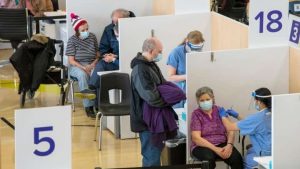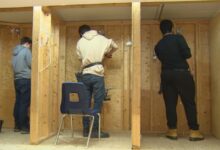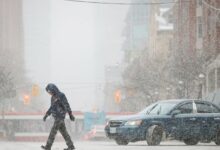Ontario imposes stay-at-home order as COVID-19 cases surge but stops short of instituting paid sick days

Ontario has declared its third provincewide state of emergency, issuing a stay-at-home order effective 12:01 a.m. Thursday as the number of COVID-19 cases surge.
Teenager dies of COVID-19 in Montreal, youngest victim of pandemic in Quebec
The province is also expanding vaccine eligibility for more people over the age of 18 in regions hardest hit by the virus, starting with Toronto and Peel.
Premier Doug Ford said that mobile teams are being organized to offer vaccines in high-risk congregate settings, residential buildings, faith-based locations, and places occupied by large employers in hot spot neighbourhoods. Education workers in high-risk neighbourhoods will be allowed to book vaccinations starting next week, he said.
“I continue to ask everyone to get a vaccine as soon as you’re eligible to do so,” Ford said, adding that those who are eligible but haven’t taken the vaccine are “putting your life in jeopardy.”
Ford also said if vaccination supplies stay consistent, he hopes to have 40 per cent of Ontario adults vaccinated by the end of the new, four-week stay-at-home order.
The new measures do not include paid sick days, despite repeated calls by medical professionals, including the medical officers of health from Toronto, Peel and Ottawa.
“There’s paid sick leave from the federal government,” Ford said Wednesday. He accused those calling for his government to ensure paid sick days of “playing politics,” before repeatedly urging people to use the federal program.
The federal government last fall introduced the Canada Recovery Sickness Benefit, which provides $500 per week for up to two weeks to eligible workers. Critics say the program provides less than a full-time minimum wage job, involves processing delays of up to four weeks, and doesn’t guarantee job security for workers who use it.
The order requires all Ontarians to remain at home except for essential purposes such as grocery shopping, accessing healthcare services (including COVID-19 vaccinations), work that cannot be done remotely and exercise close to home with only those from one’s household.
Non-essential retailers will be limited to curbside pick-up and delivery. Access to malls will be limited to specific purposes such as curbside pick-up. Big-box store retail will also be limited to selling essential items such as groceries, household supplies, pharmacy items and personal care items.
Schools and childcare will remain open in public health regions that permit them to be open.
Residential evictions will also be halted.
Capacity will be limited to 25 and by-appointment-only at safety supply stores, optical stores, businesses selling motor vehicles, boat and other watercraft, vehicle repair and rental, telecommunications retailers. Garden centres and nurseries can continue to operate with 25 per cent capacity.
The move comes in the wake of criticism that restrictions announced last week — what the government called “emergency brake” measures — are insufficient to slow the spread of Ontario’s third wave of COVID-19.
The Ministry of Health reported another 3,215 cases of the illness Wednesday morning, the most on a single day since Jan. 17, when the second wave was at its peak in the province. Health units also logged 17 more deaths of people with COVID-19, pushing the official toll to 7,475.
The seven-day average of daily cases has climbed to 2,988, its highest point since Jan. 18.
The upward trend in new infections comes as the province logged a record-high day for vaccinations, with 104,382 doses administered yesterday, according to the ministry.
Earlier Tuesday, Ford defended the measures he’d announced last week, yet hinted additional restrictions were coming.
“I think we made massive moves last week by basically shutting down the entire province,” Ford said during a news conference Tuesday afternoon.
“That was huge, shutting down thousands and thousands of businesses, that I hate doing, but we’re going to have further restrictions moving forward, very, very quickly.”
Even though the government’s measures left malls open over the Easter weekend, Ford scolded Ontarians for going shopping.
“I truly was hoping that people wouldn’t be going in there to the volume that we saw,” Ford said during the news conference.
“A lot of people were going into the malls and doing their little wander around and coming out with no bags,” he said. “I’m sorry, but going to the malls is not essential.”
Pressure has grown in recent days on the Ford government to tighten public health measures and ensure better protections for the province’s essential workers.
The medical officers of health from three of Ontario’s biggest public health units — Toronto, Peel Region and Ottawa — urged the province on Monday to impose a stay-at-home order, travel restrictions between regions and an emergency mandate for paid sick days.
The top public health doctors in Toronto and Peel Region also ordered the closure of schools, sending nearly 600,000 students to online-only classes just days ahead of a rescheduled week-long spring break. Students in the Wellington-Dufferin-Guelph health unit are similarly shifting to online learning for the time being.
Associations representing physicians and nurses issued statements saying more needed to be done to prevent further deaths and to ensure the health-care system is not overwhelmed.
Ontario has reported on average more than 2,800 new cases of COVID-19 daily over the past week. There are 504 people with COVID-19 being treated in ICUs. Admissions to intensive care previously peaked at 420 during the second wave of the pandemic earlier this year.
In Toronto, the health-care system has become so strained that the Hospital for Sick Children announced yesterday it would establish a temporary, eight-bed intensive care unit for COVID-19 patients aged 40 and under. The idea is that the new unit would help ease the burden on other hospitals in the city, which reported 1,095 more cases of COVID-19 in this morning’s update.
Ford’s expected announcement comes shortly after provincial health officials outlined Phase 2 of Ontario’s immunization campaign.
While the plan includes an effort to get vaccines to about 90 “hot spot” neighbourhoods in 13 public health units, essential workers under 50 will likely need to wait until at least Mid-May before they can book an appointment for a first dose.
Ontario’s own COVID-19 science advisory table has repeatedly cautioned that the third wave — driven largely by more transmissible and more deadly variants of concern — is dangerously outpacing the current rate of vaccinations, especially, in Toronto and Peel and York regions.
And a new analysis from ICES — an Ontario research organization that tracks data on a broad range of health-care issues — used postal codes to show people in Toronto’s hardest-hit neighbourhoods aren’t accessing COVID-19 vaccines at the same rate as those in higher-income areas that have seen far fewer infections.
For example, in the tony St. Clair and Rosedale area about 22.4 per cent of eligible adults have had at least one dose of a COVID-19 vaccine, the most in any part of the city.
Compare that to the Jane and Finch area, where only 5.5 per cent of eligible adults have gotten their first shot, despite having a rate of hospitalizations and deaths from the illness more than eight times that of St. Clair and Rosedale.








Redes Sociais - Comentários